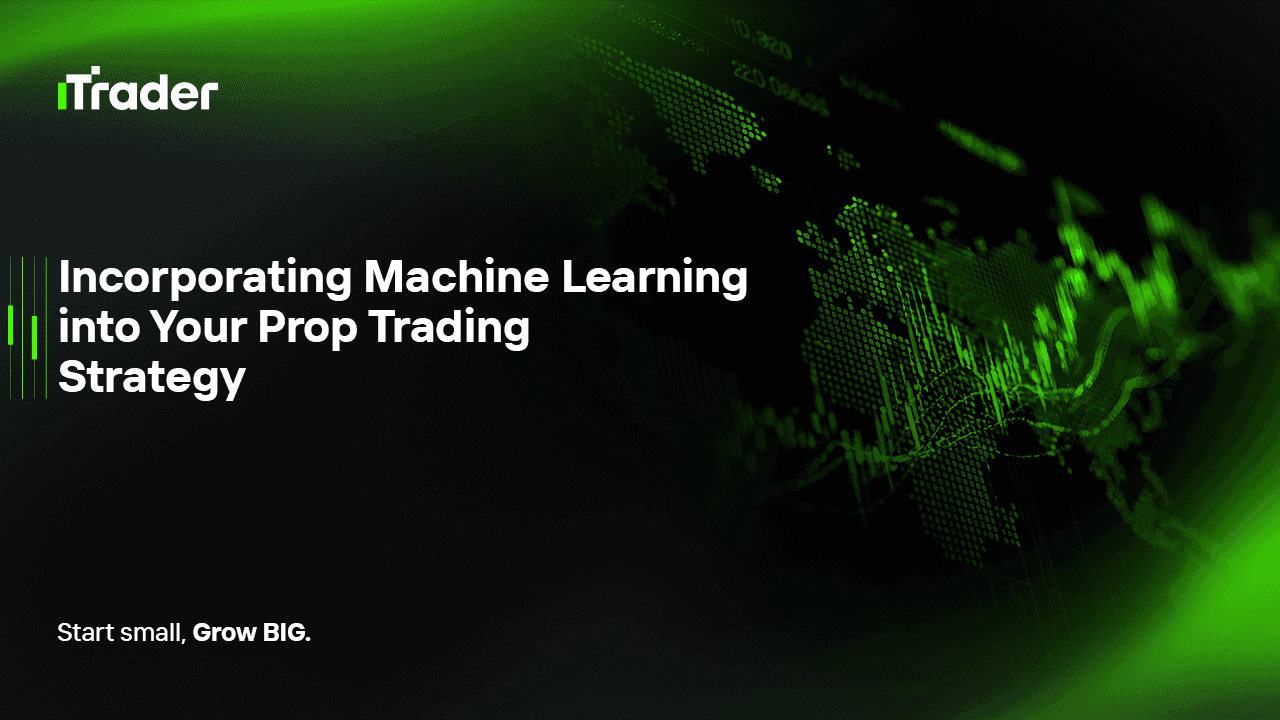2025-07-25
In forex market, the most successful traders are not those relying solely on intuition, but those who make decisions rooted in data, probability, and systems thinking. With the rapid evolution of financial technology, machine learning (ML) and artificial intelligence (AI) are becoming essential tools that help traders minimize cognitive errors, discover market patterns, and automate decision-making with precision. For proprietary traders—where performance consistency is vital—ML/AI offers a competitive edge by turning raw data into actionable signals.

AI Summary:
This blog explores how machine learning (ML) and artificial intelligence (AI) can be integrated into forex trading strategies, specifically tailored for proprietary traders. It walks through the strategic benefits of using data-driven models, practical applications such as regime detection and signal generation, and outlines a structured roadmap to deploy ML/AI in trading systems. The goal is to help traders increase adaptability, reduce emotional bias, and build robust systems that adjust with market conditions.
Artificial Intelligence (AI) refers to systems that mimic human decision-making and reasoning, while Machine Learning (ML) is a subfield of AI focused on algorithms that learn from data patterns and improve over time without being explicitly programmed. In trading, AI supports automation and adaptation, whereas ML is used to forecast prices, detect regimes, and generate signals based on learned patterns.
1. Pattern Detection Beyond Human Intuition
ML models can identify complex, nonlinear relationships that are often invisible to traditional indicators. These patterns are often scale-invariant and dynamic—ideal for high-volatility environments.
2. Real-Time Adaptation
As market conditions shift, ML models can retrain on new data and respond faster than rule-based systems, which often require manual reconfiguration.
3. Systematic Decision-Making
Machine learning helps eliminate emotional bias, enabling objective, repeatable strategies. It’s particularly effective when testing thousands of scenarios across multiple timeframes or instruments.
A. Direction Prediction
Supervised learning models such as logistic regression, random forests, and XGBoost can classify market direction based on features like moving average crossovers, RSI levels, and macro indicators. The output helps decide whether to go long, short, or stay neutral.
B. Signal Generation
Time-series forecasting techniques, including ARIMA, Prophet, and LSTM (a deep learning model), can be used to predict price movements and generate trading signals. When the model forecasts significant directional movement, it triggers trade entries or exits.
C. Regime Detection and Strategy Switching
Unsupervised learning methods help detect structural changes in the market—such as volatility spikes or trend exhaustion. Techniques like PCA and K-means clustering group similar market environments, allowing you to apply different strategies per regime.
D. Sentiment Analysis Using NLP
Natural Language Processing (NLP) allows you to extract market sentiment from social media, news feeds, or financial reports. Models like BERT or RoBERTa can analyze tone and context to forecast risk-on or risk-off behavior in the market.
1. Data Collection and Preparation
Start by gathering high-quality price data, macroeconomic indicators, and possibly text-based data. Clean and normalize the data to remove noise, fill gaps, and standardize formats.
2. Model Selection and Training
Choose an appropriate ML technique depending on your goal: supervised for prediction, unsupervised for clustering, or reinforcement learning for decision-making under uncertainty. Use cross-validation and regularization techniques to avoid overfitting.
3. Backtesting and Forward Testing
Apply your model to historical data using realistic trading conditions, including slippage, spreads, and execution delays. Use walk-forward analysis to simulate how your model performs in changing market environments.
4. Deployment into Live Trading
Integrate your model with platforms like MetaTrader via Python APIs or connect it to your broker’s execution system. Ensure the strategy includes real-time monitoring and alert systems to track performance and intervene if needed.
Advantages:
Challenges:
Proprietary firms are actively integrating ML/AI across several key areas:
While some firms hire quantitative researchers and data scientists to build complex models, others empower traders to construct semi-automated strategies using open-source tools and cloud-based infrastructure.
Explainable AI (XAI):
New frameworks are emerging to help traders understand why an AI model made a certain decision, improving trust and transparency.
Reinforcement Learning:
AI agents learn by receiving rewards or penalties for trading outcomes, making them ideal for complex environments like order flow prediction or multi-asset allocation.
Multi-Agent Systems:
Simulating market environments using multiple AI agents that compete or cooperate to discover emergent trading strategies.
Synthetic Data Generation:
Generative models like GANs are being used to create artificial price series for robust testing across unseen scenarios.
Machine learning and artificial intelligence are not magic bullets, but they can vastly improve the precision, consistency, and adaptability of your trading systems. For prop traders, where performance is everything, AI can help filter noise, reveal edge, and automate complex decisions. However, successful adoption requires a deep understanding of both markets and machine learning principles. Those who combine domain expertise with data science will be at the forefront of next-generation trading.
© 2025 iTrader Global Limited|会社登録番号:15962
iTrader Global Limitedは、コモロ連合のアンジュアン自治島ムツァムドゥのHamchakoに所在し、コモロ証券委員会によって認可・規制を受けています。ライセンス番号は L15962/ITGL です。
iTrader Global Limitedは「iTrader」の商号で運営しており、外国為替取引業務を行う許可を受けています。会社のロゴ、商標、ウェブサイトはすべて iTrader Global Limited の専有財産です。
iTrader Global Limitedの他の子会社には、iTrader Global Pty Ltd(オーストラリア会社登録番号(ACN):686 857 198)が含まれます。 この会社は、Opheleo Holdings Pty Ltd(オーストラリア金融サービスライセンス(AFSL)番号:000224485)の認可を受けた代表者(AFS代表番号:001315037)です。登録住所は Level 1, 256 Rundle St, Adelaide, SA 5000 です。
免責事項: この法人は、本ウェブサイト上で取引される金融商品の発行者ではなく、それらに対して責任を負いません。
リスク警告: 差金決済取引(CFD)は、レバレッジにより資本の急速な損失リスクが高く、すべての利用者に適しているとは限りません。
ファンド、CFD、その他の高レバレッジ商品を取引するには、専門的な知識が必要です。
調査によると、84.01%のレバレッジ取引者が損失を被っています。取引を開始する前に、リスクを十分に理解し、資金を失う可能性があることを認識してください。
iTraderは、レバレッジ取引によるリスク、損失、またはその他の損害について、個人または法人に対して一切の責任を負わないことを明言します。
利用制限: iTraderは、法律、規制、または政策によりこのような活動が禁止されている国の居住者を対象として、本ウェブサイトやサービスを提供していません。